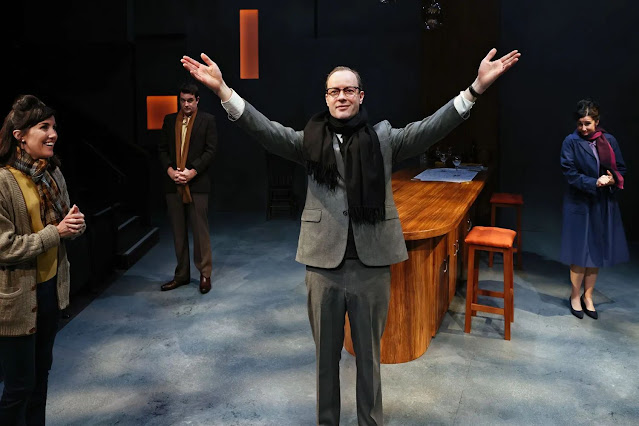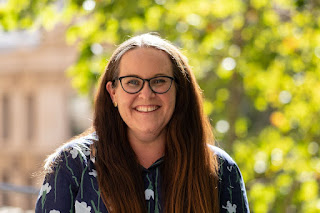Benefactors by Michael Frayn. Ensemble Theatre, Sydney, June 16 – July 22, 2023.
Reviewed by Frank McKone
June 24
Director – Mark Kilmurry
Assistant Director – Margaret Thanos
Set & Costume Designer – Nick Fry
Lighting Designer – Matt Cox
Sound Designer – David Grigg
Dialect Coach - Linda Nicholls-Gidley
Hair Stylist – Lindsey Chapman
Cast:
Jane – Emma Palmer David – Gareth Davies
Sheila – Megan Drury Colin – Matt Minto
Photos by Prudence Upton
 |
| David enthuses about skyscrapers L-R: Megan Drury, Matt Minto, Gareth Davies, Emma Palmer as Sheila, Colin, David and Jane in Benefactors by Michael Frayn, Ensemble Theatre 2023 Photo: Prudence Upton |
Like theatres everywhere, Ensemble nowadays asks for donations: This
year, we’re celebrating an amazing 65 years. Your support is key to our
ongoing success, creating exceptional theatre that you have come to
expect from Ensemble.
As Wikipedia informs us: It is
Australia's longest continuously running professional theatre group,
having given its first performance in Cammeray Children's Library on 11
May 1958. It relocated to the current premises in the old boatshed on
the shore of Careening Cove in 1960.
As theatre enthusiast,
drama teacher and reviewer I have watched the inspirational leadership
of founder Hayes Gordon, then Sandra Bates from 1986 – while Hayes
continued to run the Ensemble Studios acting school until his death in
1999 – and then Sandra’s protégé Mark Kilmurry since her retirement in
2015.
I am certain this production of Benefactors
would make Hayes and Sandra proud. Mark’s directing of the actors’
characterisations show all the essential elements of Hayes’ instructive
approach to Stanislavsky and method acting (Acting and Performing
1992), and of Sandra’s precision of style, which are the core of great
theatre. The Ensemble remains a small, personal, human theatre which
fulfils the social import expressed in the song by Kev Carmody and Paul
Kelly, From Little Things Big Things Grow.
This is exactly
how Michael Frayn’s play works. David is an architect, but the twist
is that in the end it’s the big things – like what the community really
want – that make his ambition to build 50-storey skyscrapers for housing
people, come to nought. But David is really a very nice man, while his
nemesis, Colin, who leads the anti-skyscraper campaign, is worse than
unlikeable. No wonder Sheila, Colin’s wife, is in love with David;
while David’s wife Jane has to admit she has just a touch of the dark
side, like Colin – but only just enough for her to turn out to be the
only practical one of the four.
The great thing about Kilmurry
choosing this play – and working so well with such finely-tuned actors –
is that Frayn writes with a surprising yet satisfying combination of a
depth of concern for his characters with a great sense of humour. Time
and again, we find ourselves laughing while recognising how real these
characters’ thoughts and feelings are – in ourselves. Each character at
different points of conflict tells us directly, individually, how they
remember what really happened so that we are not always on the outside
looking on, but every now and then take part in the story, as if we had
met Jane, Sheila, Colin or David over coffee, at least as acquaintances
if not exactly friends.
This device, time-shifting, brings out the clever side of Michael Frayn – and it works a treat.
And
then, in addition, here is a play, written in 1984 but, through the
characters’ reminiscences about what had actually happened back in the
1960s, reflecting on the very issues – social housing, homelessness, the
inflating costs of houses, and the inability of the well-enough off to
understand – which London was facing then and we face again today.
 |
| Matt Minto as Colin in anti-skyscraper campaign mode Megan Drury as Sheila, reading report in Benefactors, Ensemble 2023 |
So, in my view, you have no excuse for not going to Kirribilli to see Benefactors in the Ensemble boatshed. Or perhaps Jordan Best, at The Q, that also quite small if not quite as intimate theatre in Queanbeyan, might make an arrangement with Mark Kilmurry. I’m sure it would work very well there.
 |
| Megan Drury and Emma Palmer as Sheila and Jane in Benefactors, Ensemble 2023 |
© Frank McKone, Canberra

















